The continued frigid weather has compelled the folks at the Brooklyn Lyceum to cancel the first shanty sing scheduled for tomorrow night. Apparently the heating system in the 3,600-square-foot brick-lined theater with cavernous ceilings, is not up to the bitterly cold weather that we are experiencing here in New York. The shanty sing will be rescheduled.
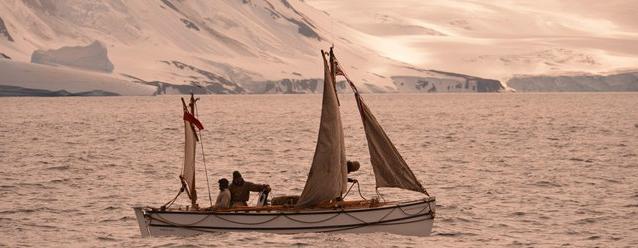
Photo: Shackleton Epic
In the Antarctic winter of 1916, Ernest Shackleton and a crew of five sailed in a decked over lifeboat from Elephant Island to South Georgia. They were on a desperate rescue mission across 800 miles of the roughest ocean in the world, seeking help for the rest of the crew of the Shackleton’s expedition, which had spent two years on the Antarctic ice. Now almost 100 years later, the Shackleton Epic Expedition led by Tim Jarvis has set off from near Point Wild on Elephant Island to recreate the extraordinary voyage in a replica lifeboat, named the Alexandra Shackleton, in honor of the explorer’s granddaughter. See our previous post from last March.
Adventurers recreate ‘greatest survival story’ of the Antarctic
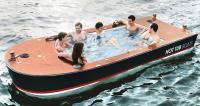 Only on rare occasional does one find a boat that would be significantly improved if run hard aground. Here is one example, however. Many large yachts have hot tubs onboard. This 16′ boat, however, is simply a floating hot tub with a diesel-powered boiler to keep the water hot, an electric motor for propulsion, a sound system and four coolers for beverages (of course.) I wonder where the PFDs are stored. Why this nautical accident-waiting-to-happen is in any way superior to a dock-side hot tub is not clear to me. With luck it would never leave the dock. Available at Hammacher Schlemmer for a price of $42,000.
Only on rare occasional does one find a boat that would be significantly improved if run hard aground. Here is one example, however. Many large yachts have hot tubs onboard. This 16′ boat, however, is simply a floating hot tub with a diesel-powered boiler to keep the water hot, an electric motor for propulsion, a sound system and four coolers for beverages (of course.) I wonder where the PFDs are stored. Why this nautical accident-waiting-to-happen is in any way superior to a dock-side hot tub is not clear to me. With luck it would never leave the dock. Available at Hammacher Schlemmer for a price of $42,000.
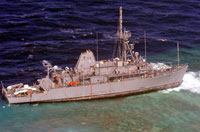
Photo:ARMED FORCES OF THE PHILIPPINES
The minesweeper USS Guardian ran aground on a reef at the Tubbataha marine park in the Sula Sea last Thursday. The ship is still there. So far there has been no reported leaks of fuel leaks though the Navy has confirmed that multiple spaces aboard the ship have been flooded. The worsen weather may threaten the salvage of the ship. The north east monsoon winds known as the Amihan are expected to worsen over the next few days.
As reported by GMA News: “The strong northeasterly wind and the associated big waves could affect any operation to rescue the US vessel. One thing to consider is there is another surge of the northeast monsoon this week, so expect stronger winds and heavier seas,” GMA News’ resident meteorologist Nathaniel “Mang Tani” Cruz said.
Time running out for USS Guardian in Tubbataha as Amihan winds intensify
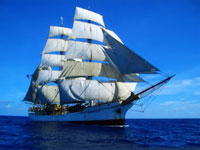
Barque Picton Castle
Happy Bounty Day! On Pitcairn Island, Bounty Day is celebrated yearly on January 23, in commemoration of the burning of the HMS Bounty by the mutineers in 1790. The sail training ship Picton Castle arrived just in time to partake in the celebrations. From the Captain’s Log/Facebook:
All hands were woken at 0700 to sail past Adamstown, Pitcairn Island. At 0810 we anchored off Tedside in light conditions, with 3 shots of chain out in 10 fathoms of water, concluding a 25 day passage from the Galapagos. Hello Pitcairn! We made it to Pitcairn just in time to celebrate Bounty Day – looking forward to sharing in the festivities! Happy Bounty Day to all!
The Picton Castle is a three masted steel barque operating as sail training vessel currently on a South Pacific voyage. After transiting the Panama canal the Picton Castle sailed for the Galapagos and then on to Pitcairn. The voyage will take the ship to French Polynesia, onward through the Cook islands with stops in Tonga and Samoa before ending in Rarotonga.
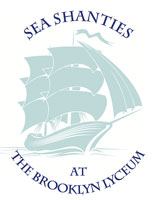 This Friday, January 25th, from 8 to 10PM, a waterfront tradition will be returning to Brooklyn. The first of planned monthly shanty sings will be held at the Brooklyn Lyceum. All lovers of the music of the sea are welcome. This Friday’s session is being held in memory of Howie Leifer, who recently died of cancer. Howie was long-time member of the sea shanty community in New York, as well as a wonderful entertainer and gifted puppeteer.
This Friday, January 25th, from 8 to 10PM, a waterfront tradition will be returning to Brooklyn. The first of planned monthly shanty sings will be held at the Brooklyn Lyceum. All lovers of the music of the sea are welcome. This Friday’s session is being held in memory of Howie Leifer, who recently died of cancer. Howie was long-time member of the sea shanty community in New York, as well as a wonderful entertainer and gifted puppeteer.
The Brooklyn Lyceum is at 227 4th Avenue on the corner of President Street, in Brooklyn, New York. Accessible by subway on the R train to Union Street. Hot chocolate and mulled wine will be served to help keep away the cold. Cost: $5.00
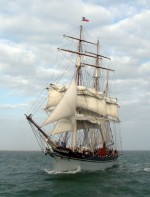 The three masted iron barque Elissa, built in 1877, will be returning to her pier this Saturday at the Texas Seaport Museum in Galveston after completing a $3 million repair and replacement of hull plating. Congratulations to Jamie White and all the staff, partners and volunteers who tirelessly raised funds and worked to bring the ship back from near disaster. As we posted in August of 2011, the Elissa was a a victim of stray current electrolysis due to electrical cables breaking and falling into the water during Hurricane Ike in September 2008. The damage was found at the next drydocking when it was discovered that 16% of the hull plating had suffered from the electrolytic corrosion. After a period of intensive planning and fundraising, the grand old ship was put on dock four and a half months ago at Bollinger Shipyard. With new and repaired plating, the Elissa is expected to arrive back at her berth around 1PM and will be open to the public from 3 – 5PM.
The three masted iron barque Elissa, built in 1877, will be returning to her pier this Saturday at the Texas Seaport Museum in Galveston after completing a $3 million repair and replacement of hull plating. Congratulations to Jamie White and all the staff, partners and volunteers who tirelessly raised funds and worked to bring the ship back from near disaster. As we posted in August of 2011, the Elissa was a a victim of stray current electrolysis due to electrical cables breaking and falling into the water during Hurricane Ike in September 2008. The damage was found at the next drydocking when it was discovered that 16% of the hull plating had suffered from the electrolytic corrosion. After a period of intensive planning and fundraising, the grand old ship was put on dock four and a half months ago at Bollinger Shipyard. With new and repaired plating, the Elissa is expected to arrive back at her berth around 1PM and will be open to the public from 3 – 5PM.
In February 2001, we posted about the problem that the US Navy has been having with the “synthetic marijuana” often referred to as “spice.” Since then the Navy has discharged over 200 sailors for use of the “spice.” Earlier this month, the Navy issued a rather disturbing public service announcement warning about the danger of another, but very different, designer drug – “bath salts.” Thanks to Phil Leon for contributing to the post.
 Recent winter storms have washed ashore four large, barrel-shaped pieces of lard onto the beach at St.Cyrus nature reserve in Scotland. They are believed to be from the wreck of a merchant vessel that was bombed in WW II. Therese Alampo, St Cyrus reserve manager, said, “The depth of the swell during the storms we had over the holidays must have broke apart the shipwreck some more and caused the lard to escape….The lard was covered in the largest barnacles I’ve ever seen. Animals, including my dog, have certainly enjoyed the lard, and it still looks and smells good enough to have a fry up with.” Personally, I would prefer to avoid “fry ups” with barnacle covered lard, but perhaps I am being too picky. Thanks to Niall Sinclair for passing the news along.
Recent winter storms have washed ashore four large, barrel-shaped pieces of lard onto the beach at St.Cyrus nature reserve in Scotland. They are believed to be from the wreck of a merchant vessel that was bombed in WW II. Therese Alampo, St Cyrus reserve manager, said, “The depth of the swell during the storms we had over the holidays must have broke apart the shipwreck some more and caused the lard to escape….The lard was covered in the largest barnacles I’ve ever seen. Animals, including my dog, have certainly enjoyed the lard, and it still looks and smells good enough to have a fry up with.” Personally, I would prefer to avoid “fry ups” with barnacle covered lard, but perhaps I am being too picky. Thanks to Niall Sinclair for passing the news along.
It is a cold winter’s morning here on the western shore of New York Harbor. On such a morning, it is great to just sit back and get lost in images of a crystal clear ocean teaming with sea life. Here is a video by Liquid Media filmed around Koh Tao in the Gulf of Thailand. (Click on the icon in the lower right corner to open it to full screen.)
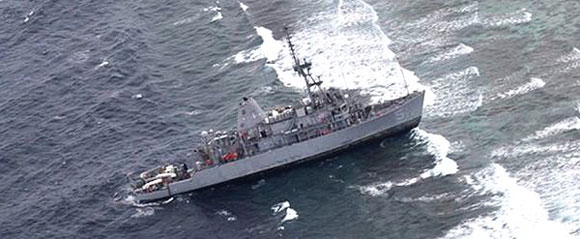
USS Guardian on Tubbataha Reef Photo:AP
In 2005, when the Greenpeace flagship, Rainbow Warrior, ran aground on Tubbataha Reef in the Sulu Sea, the captain claimed that the reef was incorrectly plotted on his charts. As reported by the UK’s Guardian in November 1, 2005:
Red Constantino of Greenpeace Southeast Asia blamed the incident on a maritime chart that showed that the Rainbow Warrior was supposed to be 1 ½ miles away from the reef when it ran aground. He said within minutes of the incident, Greenpeace contacted the marine park ranger station. “This accident could have been avoided if the chart was accurate,” he said. “We feel responsible, however.”
It appears that the charts may not have been corrected in the intervening seven years, as the US Navy is now also blaming the Thursday morning grounding of the USS Guardian on Tubbataha Reef on inaccurate charts.
We should probably add a new category to the blog, something along the lines of “You Can’t Make This Stuff Up.” This post would certainly fit. The Norwegian Seafood Council has sponsored Human Sushi, a series of dances to interpret sushi and sashimi recipes. From their website:
The Human Sushi is a performance group that interprets sushi recipes in their own way. This cheerful gang is led by Arthur, an energetic Norwegian speaking Frenchman. Together they dance until both maki, nigiri and sashimi. Which dance performance do you like best?
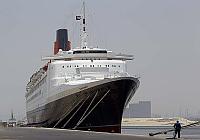 Four years ago, the luxury liner Queen Elizabeth 2 was sold to financial interests in Dubai who planned on converting her to a luxury hotel. Unfortunately, the arrival of the ship coincided with a credit crunch and near financial melt-down in the emirate. Last July, a more modest hotel conversion plan in a less fashionable section of Dubai was announced for the QE2, after the luxury hotel plan fell through. Then, just before Christmas, it was reported that the ship had been sold for scrap to Chinese interests for £20 million. Not long afterwards, ambitious, though rather vague, plans were announced to convert the ship to a luxury hotel and move her back to the Thames.
Four years ago, the luxury liner Queen Elizabeth 2 was sold to financial interests in Dubai who planned on converting her to a luxury hotel. Unfortunately, the arrival of the ship coincided with a credit crunch and near financial melt-down in the emirate. Last July, a more modest hotel conversion plan in a less fashionable section of Dubai was announced for the QE2, after the luxury hotel plan fell through. Then, just before Christmas, it was reported that the ship had been sold for scrap to Chinese interests for £20 million. Not long afterwards, ambitious, though rather vague, plans were announced to convert the ship to a luxury hotel and move her back to the Thames.
And now it has been announced that an agreement has been signed with Oceanic Group Pte Ltd., a cruise company with offices in Singapore, Hong Kong and Shanghai, to convert the ship into a five-star hotel. Other terms of the deal, including where the converted ship/hotel will be operated, have not been disclosed. From the Oceanic Group website:
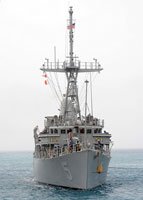 The minesweeper USS Guardian ran aground early this morning on a reef in the Philippines’ Tubbataha National Marine Park. The park is a World Heritage Site in the Sulu Sea, 640 kilometers (400 miles) southeast of Manila. USS Guardian is an Avenger-class minesweeper which had just ended a port call at Subic Bay and was bound for Puerto Princesa when it struck the reef. Thus far there have been no reports of fuel oil leaks. The Navy said in a statement that the crew of the USS Guardian was working to find out the best method of safely extracting the ship. The 224′ long ship has a wooden hull, sheathed in fiberglass, and was built at Peterson Shipbuilders. The Guardian is based in Sasebo, Japan.
The minesweeper USS Guardian ran aground early this morning on a reef in the Philippines’ Tubbataha National Marine Park. The park is a World Heritage Site in the Sulu Sea, 640 kilometers (400 miles) southeast of Manila. USS Guardian is an Avenger-class minesweeper which had just ended a port call at Subic Bay and was bound for Puerto Princesa when it struck the reef. Thus far there have been no reports of fuel oil leaks. The Navy said in a statement that the crew of the USS Guardian was working to find out the best method of safely extracting the ship. The 224′ long ship has a wooden hull, sheathed in fiberglass, and was built at Peterson Shipbuilders. The Guardian is based in Sasebo, Japan.
US navy ship runs aground on Tubbataha Reef
It is not clear whether coral has been damaged by the grounding. The Philippine government assess a fine of roughly $300 dollars per square meter of coral damaged. In 2005, the environmental group Greenpeace paid a fine of around $7,000 after their flagship Rainbow Warrior also grounded on Tubbataha reef. Thanks to Ulrich Rudofsky for contributing to this post.
New Scientist TV has a fascinating video of what it refers to as a “disco clam.” Oddly they don’t provide the scientific name for the clam. My guess is that it isn’t “disco.”
Video captures disco clams producing strobe light show
The disco clam is surely the king of party animals. It’s the only bivalve known to produce a controlled light show, creating a flashing strobe effect as it rolls up then unfurls a reflective lip.
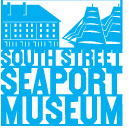 When I first visited New York’s South Street Seaport in the early 70s, it was a fairly lonely place. There was no shopping mall on Pier 17 and the high-end chain-stores like Guess, Abecrombe and Fitch and Brookstone had not yet been attracted to the historic buildings along Fulton, Water and Front Streets. Many of the old warehouses and boarding houses were still shuttered.
When I first visited New York’s South Street Seaport in the early 70s, it was a fairly lonely place. There was no shopping mall on Pier 17 and the high-end chain-stores like Guess, Abecrombe and Fitch and Brookstone had not yet been attracted to the historic buildings along Fulton, Water and Front Streets. Many of the old warehouses and boarding houses were still shuttered.
Last night at the Seaport, I had a strong sense of déjà vu. After Superstorm Sandy, most of the stores are still boarded up and dark. The one bright light, both figuratively and literally, was the South Street Seaport Museum which held an Opening Party, celebrating the post-Sandy reopening of the Museum at 12 Fulton Street and the Bowne Printers at 209 Water Street, next to the reopened Bowne and Company. The Museum also opened two new exhibits, “A Fisherman’s Dream, Folk Art by Mario Sanchez” and “Street Shots/NYC.”
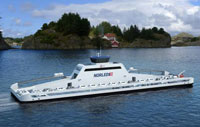 The Norwegian shipyard Fjellstrand and Siemens are developing the world’s first electrically powered car ferry. Starting in 2015, the 80-meter ferry will will operate across the Sognefjord between the towns of Lavik and Oppedal. The ferry will have the capacity to carry 120 cars and 360 passengers. Remarkably the batteries which power the ferry will be able to recharge in only 10 minutes.
The Norwegian shipyard Fjellstrand and Siemens are developing the world’s first electrically powered car ferry. Starting in 2015, the 80-meter ferry will will operate across the Sognefjord between the towns of Lavik and Oppedal. The ferry will have the capacity to carry 120 cars and 360 passengers. Remarkably the batteries which power the ferry will be able to recharge in only 10 minutes.
Workers from New York’s Central Park Conservancy were removing rust from a cannon originally from the British 28 gun frigate HMS Hussar, which sank in New York’s East River in 1780. After removing a concrete plug from the mouth of the cannon, they were shocked to realize that the gun was still loaded with round shot, wadding and a cartridge of powder. The cannon had been donated to the city in 1865 and had been on display before being moved to a shed in Central Park for safe keeping. Almost, though not quite, a “blast from the past.”
;
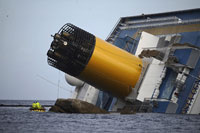 If the reporting is accurate, this doesn’t seem like the argument that Carnival should be making.
If the reporting is accurate, this doesn’t seem like the argument that Carnival should be making.
Passengers ‘blamed’ for Concordia damages
Costa Cruises parent company Carnival is said to have blamed passengers, at least in part, for the damages they sustained in the Costa Concordia shipwreck a year ago in documents pertaining to a law suit in the United States, according to the passengers’ lawyers. The disaster off Tuscany’s Giglio Island on January 13, 2011 claimed the lives of 32 people The John Arthur Eaves law firm, which is representing the passengers, said the Miami-based Carnival Corp wrote in court documents that “passengers’ negligent or careless behavior were among the causes, if not the only cause, of the alleged injuries and damages”.
Something things just don’t go as planned. The tug, Christos 22, was towing the decommissioned former German Naval training ship, MV Emsstrom, from Germany to Turkey. On Sunday night, the tug slowed to check a problem with the tow off Hope’s Nose near Torbay, Devon, when it was struck by the ship that it was towing. Both vessels began to take on water. Lifeboats and support vessels from Torbay and Exmouth responded to a distress call and rescued the eight crew from the tug, who were unhurt.
The region is a popular tourist destination and there were concerns that the 200 tonnes of fuel aboard the tug could create considerable pollution if it sank. Support tugs with engineers were dispatched to perform temporary repairs and to stabilize the Christos 22, which is now being towed to port. The pollution risk is now reported to be low. The MV Emsstrom, which was an empty hull and posed no risk of pollution, was reported to have subsequently sunk in deep water. Thanks to Alaric Bond, David Hayes and David Rye for contributing to the post.
